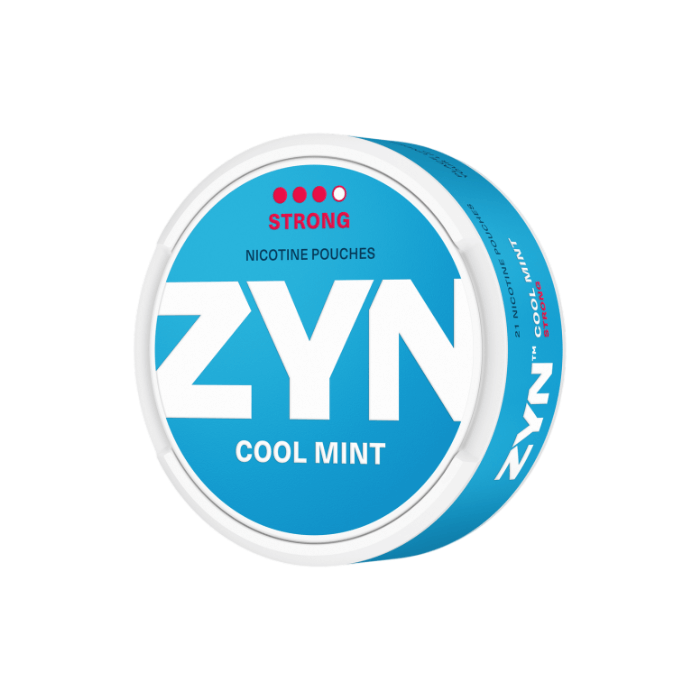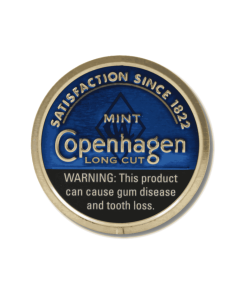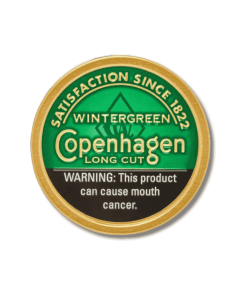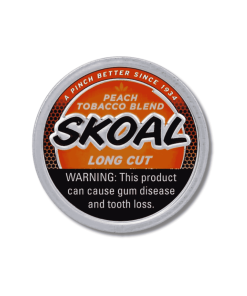Dipping Tobacco, Health
Effects of Dipping Tobacco on the Body
When talking about tobacco products, most people would first think of cigarettes, cigars, and other combustible products. Some even mistake vaping devices or e-cigarettes for tobacco products. Tobacco enthusiasts, however, know that another group of tobacco products exist.Smokeless tobacco is another group of tobacco products that have surprisingly captured a lot of adult tobacco users. While smokeless tobacco products might not be as popular as cigarettes, they are actually being sold in high volumes, reaching as high as millions of dollars in sales yearly. One product that many smokeless tobacco users depend on right now is dipping tobacco.Dipping tobacco is a type of smokeless tobacco that is made from finely ground tobacco. It is typically consumed by placing it between the lip or cheek and gum. Since dipping tobacco doesn’t involve combustion, you might think that it doesn’t cause too much harm to your body. But what really is the truth behind this? Continue reading below to know the effects of dipping tobacco on your body.
Health Risks
Before we dive deeper into the health risks of dipping tobacco, it’s ideal for us to explore the key characteristics of the said smokeless tobacco product.
Dipping tobacco, as mentioned earlier, is a type of smokeless tobacco made from finely ground or shredded leaves. Commonly known as dip, it is consumed by placing a pinch of tobacco between the lip and gum.
Some more terms for dipping tobacco include chaw, snuff, rub, and fresh leaf. Most of the time, dipping tobacco is packed in tins or cans. It is also available in rolls, logs, or sleeves.
At Native Smokes 4 Less, you can essentially buy dipping tobacco in tins or cans. You can even buy them in a tub, which is typically equivalent to 6 to 12 cans. We offer various flavours of dipping tobacco from different brands, giving you more options to satisfy your cravings.
Before opening the packaging of dipping tobacco, you must first pack the can, which is done by placing your thumb and middle finger on the sides of the packaging.
You should then quickly turn the can and flick the wrist, allowing your index finger to tap the top of the can or tin.
Consuming dipping tobacco is pretty straightforward.You must often pack the dipping tobacco and place it between the lip and gum. It’s often recommended to leave it in your lower lip for a more flavourful experience.
The dip must rest on the inside lining of your mouth for around 20 to 40 minutes to get the most out of the smokeless tobacco. The tobacco will then slowly release nicotine and other alkaloids, which are absorbed by your mouth.
So, despite the absence of tobacco smoke, why does dipping tobacco still pose some health risks?
Just like other tobacco products, dipping tobacco still contains nicotine, a highly addictive chemical that grants you a soothing sensation in a short time. When you depend on dipping tobacco for the effects of nicotine too much, you’ll eventually get addicted, leading to nicotine dependence and nicotine addiction.
Moreover, dipping tobacco contains dozens of cancer-causing chemicals, which are also present in other smokeless tobacco products like chewing tobacco.Some health risks or health effects of smokeless tobacco products like dipping tobacco include:
- Addiction: One of the health risks of dipping tobacco is addiction. Nicotine is a substance that can calm you down whenever you feel stressed, anxious, or any other similar emotions. Unfortunately, if you depend heavily on its effects, you tend to consume dipping tobacco repeatedly until your body craves it almost all the time. And when you decide to withdraw from dipping tobacco, you’ll only experience withdrawal symptoms like intense cravings, anger, and a depressed mood.
- Cancer: Cancer is another effect of dipping tobacco and other smokeless tobacco products. You might think that cancers may only be acquired when you smoke cigarettes. But the truth is you can still acquire varying types of cancer when you use dipping tobacco. Using one only raises the risk of cancer of the throat, mouth, and pancreas. You might also get small white or gray patches inside your mouth called leukoplakia, which could eventually turn into cancer.
- Heart disease and stroke: Dipping tobacco and other smokeless tobacco products may also increase your heart rate and blood pressure. When you use these products in the long-term, you might only raise the risk of dying of heart disease and stroke.
- Dental disease: Oral tobacco products like dipping tobacco are comprised of sugar and irritants, which can cause cavities, worn-down teeth surfaces, tooth decay, teeth stains, bad breath, receding gums, gum disease, bone loss around roots, and tooth loss. Hence, it’s often recommended to only consume these products moderately.
- Pregnancy risk: If you’re pregnant and still use dipping tobacco, you are only putting yourself at risk of stillbirth, low birth weight, and a heart rate issue in infants. Therefore, you should top using dipping tobacco during pregnancy.
- Poisoning risk: The harmful health effects of dipping tobacco can reach children and those who don’t actually use this particular smokeless tobacco. If they accidentally consume these smokeless tobacco products, they might be poisoned by their nicotine content. Nicotine poisoning may then cause nausea, vomiting, weakness, shaking, trouble breathing, coma, and even death. Users must likewise spit tobacco juices out of their mouths to avoid the risk of nicotine poisoning.
While the health risks of dipping tobacco are somehow less concerning than those brought by cigarettes and other combustible tobacco products, they can still harm you one way or another. It’s the main reason why dipping tobacco is not considered a healthy alternative to cigarette smoking.
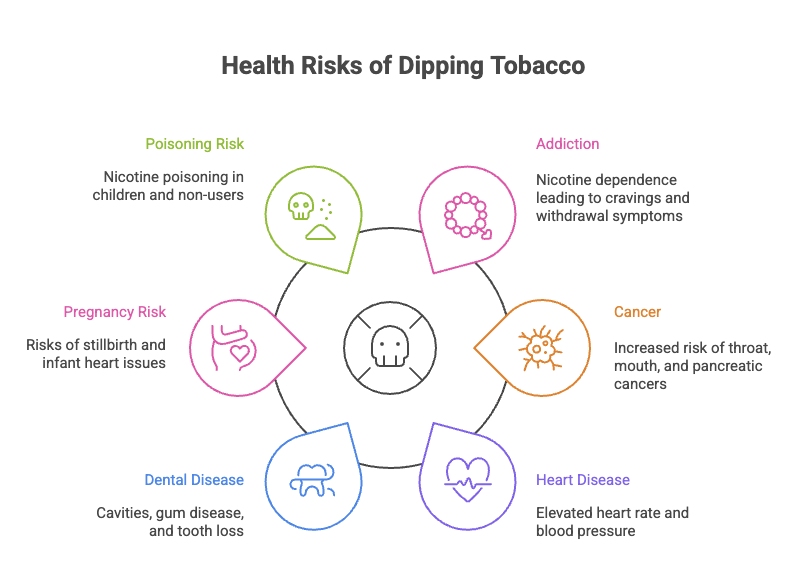
Addiction and Nicotine
One key reason why many people opt for dipping tobacco is its nicotine content.
Nicotine, in general, is a substance that all tobacco products possess. It is a highly addictive substance that tobacco leaves naturally produce. The latest advancements in technology then allowed laboratories to make their own take of nicotine without relying on tobacco.
Regardless of its source, nicotine brings a number of health effects that you might already know by now. First, it temporarily creates a feeling of well-being and relaxation. It can then increase your heart rate and the amount of oxygen your heart uses.
When the substance enters your body, it causes a surge of endorphins, relieving any stress and pain as well as improving your mood.
As nicotine reaches your brain, your nicotine levels peak quickly, which is why the feelings of reward and relaxation are short-lived. This creates a cycle of tobacco users continuing to smoke or dip/chew tobacco to maintain the satisfying sensations they are getting from tobacco products.
Regular consumption of tobacco products and other nicotine-containing products can eventually lead to addiction. Your body may then adapt to nicotine. This means you have to consume more tobacco products just to get the same effects.
It somehow pushes you to go for stronger dipping tobacco just to feel the calming sensation you typically get.
Now, when you decide not to use these products abruptly, you’ll experience withdrawal symptoms, which enhance your nicotine cravings, upset your mood, and many more. You could experience the same things once you’re finished consuming dipping tobacco.
Addiction to nicotine can, fortunately, be managed gradually through a number of treatments. These treatments include the following:
- Nicotine replacement therapy: Nicotine replacement therapy (NRT) gives users a small amount of nicotine that clings to some of their body’s nicotine receptors. This aims to reduce their nicotine cravings slowly. Some examples of NRT include nicotine patches, sprays, lozenges, or gum.
- Medications: There are a number of medications that can treat nicotine dependence or addiction. One of them is Bupropion, a medication that can target brain chemicals to help people quit tobacco use. Varenicline is another medication that somehow stimulates a specific nicotine receptor but to a lesser extent than the highly addictive chemical. A prescription-only nicotine inhaler is also available, which works by pushing the nicotine into the back of the throat.
- Counselling and psychological support: Dipping tobacco users could speak with a mental health professional for advice. Psychotherapy like cognitive behavioural therapy or CBT could also help them quit tobacco consumption. Some people can even use mindfulness, helplines, automated text messages, and self-help materials to quit dipping tobacco.
Regulating nicotine dependence and addiction takes a lot of time, effort, and courage. So, despite feeling discouraged, you should take the next steps wholeheartedly to see some viable results in the future. You can consult a professional doctor so they can guide you along the way.
Cardiovascular Risks
Different types of smokeless tobacco are being sold in the market right now.
Chewing tobacco, for instance, is a type of smokeless tobacco that is placed between the cheek and gum. It is typically sold as loose leaves, braided leaves, or compressed leaves. The saliva that accumulates in the mouth while chewing this type of smokeless tobacco is often spat out or swallowed.
Another smokeless tobacco you can get today is snuff. It is finely ground tobacco that can be either dry or moist. It is consumed by placing a pinch along the gumline, either behind the lip or between the gum and cheek. Moist snuff is often associated with dipping, although some tobacco users snort it.
Snus is a type of smokeless tobacco that is sold loose or in pouches. It is pasteurized which means tobacco companies heat it briefly at high temperatures to kill bacteria, reducing cancer-causing chemicals along the way.
Lastly, dissolvable tobacco is powdered tobacco that is pressed into shapes like tablets, strips, or sticks. Some dissolvable tobacco products contain sweeteners or flavourings. They are consumed by chewing or holding them until they dissolve.
Most of the time, people would argue that smokeless tobacco products don’t present cardiovascular risks as opposed to cigarettes and other combustible tobacco products. But, you should also remember that smokeless tobacco like dipping tobacco still contains nicotine.
The presence of nicotine makes dipping tobacco dangerous, especially when you consume it excessively. The nicotine content of dipping tobacco can somehow increase your heart rate and blood pressure. In the long term, you might only raise the risk of dying due to stroke or heart disease.
A study published in the National Library of Medicine, however, has somehow concluded that smokeless tobacco products like dipping tobacco might not be as dangerous as one may have thought.While it’s true that smokeless tobacco like dipping can truly make your heart beat faster and raise your blood pressure, it doesn’t stay high when you’re not using it. Additionally, your heart may still work well when you’re exercising or doing hard work, even if you’re consuming dipping tobacco at times.
Interestingly, smokeless tobacco users don’t possess the same health problems as regular cigarette smokers. Some more studies have even proved that smokeless tobacco users still possess similar levels of hemoglobin, hematocrit, white blood cells, antioxidant vitamins, fibrinogen, and other important blood clotting elements as non-tobacco users.
But while a number of studies have found that snuff users don’t possess thicker walls in their arteries or plaque buildup, others have shown that snuff users might still be at higher risk of heart attacks.
Given the differences in the findings among health studies, it’s important that smokeless tobacco users like you should consume dipping tobacco in moderation, especially if you value your cardiovascular health. If you want a safe alternative to dipping tobacco, you can opt for nicotine pouches or other nicotine products that don’t contain any tobacco elements.
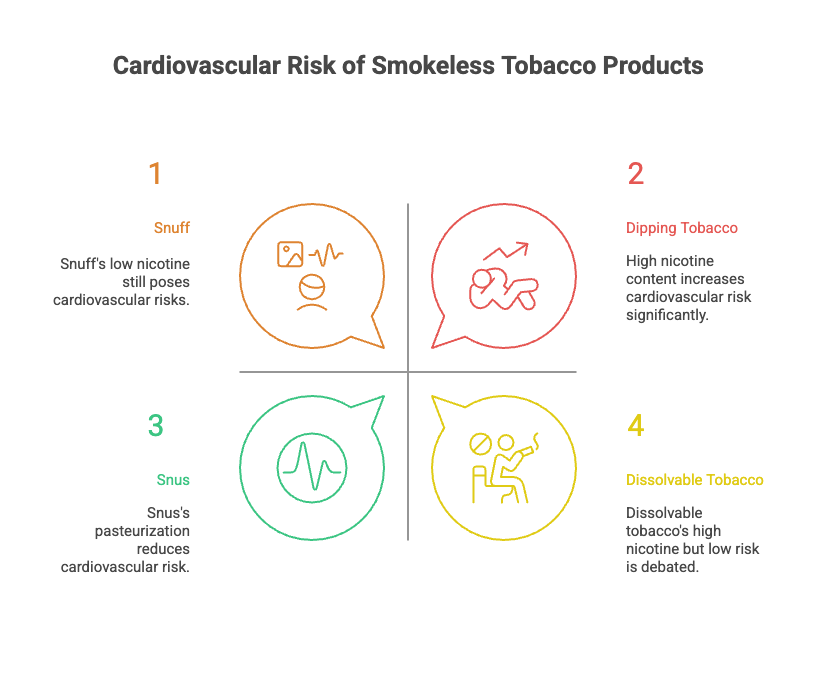
Benefits of Dipping Tobacco
Dipping tobacco, like other smokeless tobacco products available, has a controversial reputation due to its association with health risks already discussed above. Some users and researchers, however, argue that they may still provide a number of benefits compared to traditional cigarette smoking, especially when talking about tobacco harm reduction.
One of the most frequently cited benefits of using dipping tobacco is it doesn’t require the inhalation of tobacco smoke. Dipping tobacco doesn’t require combustion. You see, cigarettes typically release harmful carcinogens like tar, carbon monoxide and other chemicals due to combustion. Since dipping tobacco doesn’t have to be lit up, the number of carcinogenic particles that you may get from it will be significantly less than smoking cigarettes.
This then helps reduce the risk of certain smoking-related conditions, which include chronic obstructive pulmonary disease or COPD, emphysema, and some forms of lung diseases. The absence of inhaled smoke from tobacco can, therefore, be considered a harm-reduction benefit for those who are unable or unwilling to quit tobacco and nicotine altogether.
Another advantage of using dipping tobacco is it is more discreet than cigarettes.Cigarettes tend to produce a visible and odorous cloud of smoke, drawing a lot of attention to the people surrounding the smokers. Dipping tobacco, on the other hand, doesn’t draw any attention since it doesn’t produce any smoke. It can also save people from being exposed to second-hand smoke, which can also cause a number of serious illnesses.
So, if you want to consume tobacco in workplaces or environments where smoking is prohibited, the best option you have would be dipping tobacco. Just make sure that the place where you will be dipping tobacco permits the use of smokeless tobacco.
Dipping tobacco can likewise provide a longer-lasting nicotine effect.A single pinch of dipping tobacco can give you a steady stream of nicotine in your body for 30 minutes or more, depending on the brand and user.
It is in contrast with the shorter effect of cigarettes, which burn out quickly and typically leave users craving for more within a shorter period. The sustained delivery of nicotine may then help reduce the frequency of use throughout the day, which can somehow help users manage nicotine cravings more effectively.
If you are trying to quit smoking, dipping tobacco can serve as a transitional tool before you give up tobacco entirely. A number of systematic reviews confirmed that a lot of smokers have successfully reduced or quit smoking by opting for dipping tobacco first before tapering off.
This somehow mirrors NRT in principle, although the safety profile of dipping tobacco is not as favourable as regulated pharmaceutical products. Regardless, harm reduction advocates have argued that switching from combustible to smokeless forms of tobacco and nicotine could be a meaningful step toward smoking cessation for a number of individuals.
Even though these benefits seem to be a good thing for dipping tobacco, you must approach them with caution. Dipping tobacco, as discussed earlier, still carries significant health risks, including oral cancers, gum disease, oral cavity, addiction, and many more.
It is not entirely safe. Instead, it poses less risk, especially when compared to smoking cigarettes, cigars, and other similar products.
Economic Burden of Tobacco Use
Tobacco, in general, contains over 2,500 chemical constituents. Some of them come naturally from tobacco leaves, while others are added during cultivation, harvesting, and processing. Chewing tobacco, for instance, has added sweeteners and flavourings, while snuff has additional menthol, peppermint oil, attar of roses, oil of cloves, or camphor.
Scientific literature would then list at least 30 carcinogenic agents in smokeless tobacco products like dipping tobacco. One of the major contributors to these carcinogenic agents is tobacco-specific nitrosamines. And even though major tobacco brands claim that they have reduced the nitrosamine content of their smokeless tobacco products, they still contain carcinogenic nitrosamines in concentrations that exceed food safety limits.
The dangers of using smokeless tobacco like dipping tobacco present a massive economic burden across the globe, affecting not only individual tobacco users but also national economies and healthcare systems.
Based on the Economic Trends in Tobacco by the Centers for Disease Control and Prevention, the costs of using tobacco products in general cover multiple things: direct healthcare expenditures, indirect productivity losses, and intangible social costs. Together, they generate a cycle of financial strain, hindering economic development, particularly in low- and middle-income countries.
One evident component of the tobacco-related economic burden is the cost to healthcare systems.Tobacco users are more likely to suffer from chronic diseases such as heart disease, cancer, stroke, and respiratory conditions, all of which require ongoing and expensive medical treatment. Governments and insurance providers then shoulder a large portion of these costs, creating a drain on public resources.
In countries with universal healthcare, taxpayers indirectly bear the financial weight of treating tobacco-related illnesses. For instance, the World Health Organization or WHO estimates that tobacco-related illnesses cost billions of dollars annually in medical expenses alone.
Another major aspect is the loss of productivity caused by tobacco use. This includes absenteeism due to illness, reduced work performance, and premature death among working-age individuals. Employees who smoke or use tobacco are more likely to take frequent breaks and sick days, reducing overall workplace efficiency. Furthermore, early deaths caused by tobacco-related diseases diminish the labour force, leading to lost income for families and decreased economic output. Over time, these losses accumulate, reducing national economic potential.
Together, tobacco use leads to substantial economic losses around the world. CDC estimated that tobacco-related health expenditures and productivity losses account for approximately 1.8% of the global GDP, which amounts to around $1.85 trillion.
The financial burden on families is also significant.When a household member becomes ill due to tobacco use, the costs associated with treatment, caregiving, and lost income can push families into poverty. In low-income households, money spent on tobacco typically diverts funds away from essential needs like food, education, and healthcare. Later on, it perpetuates the cycles of poverty and poor health outcomes.
Government resources are likewise consumed when implementing tobacco control efforts, including anti-smoking campaigns, regulation enforcement, and public education programs.
Although they are essential to reducing the use of tobacco, they need funding and policy coordination that could be directed elsewhere if tobacco consumption were not so widespread. Remember, even though tobacco sales can generate a lot of tax revenue, the long-term costs to public health and economic stability far outweigh the financial gains.
Currently, current tobacco tax revenues in most low- to middle-income countries have become insufficient, often falling below 1% of GDP. They cannot even cover the true economic costs of tobacco use. The only way to bridge this gap, reduce tobacco consumption, and alleviate the economic burden is to increase tobacco taxes further.
The economic burden of tobacco is multifaceted, affecting everything from healthcare spending and workforce productivity to household stability. Effective policies and public health interventions, therefore, are necessary to reduce tobacco consumption.
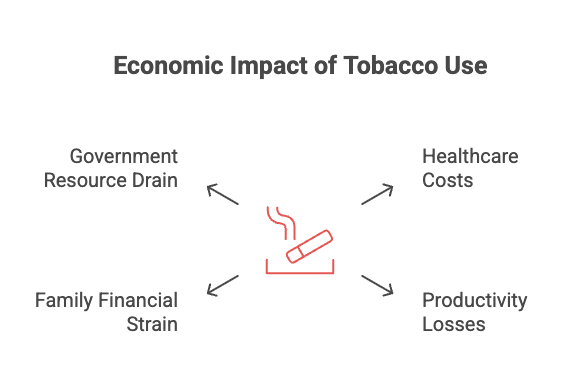
Frequently Asked Questions
What happens to your body when you dip?
When you use dipping tobacco, the nicotine from the said smokeless product is absorbed through the lining of your mouth, which causes a quick release of dopamine and increases your heart rate. Over time, using it repeatedly can lead to gum recession, tooth decay, and mouth sores. Your body might also become dependent on nicotine, increasing your risk of addiction.
What happens if you dip every day?
Dipping every day exposes your mouth tissues to constant irritation and nicotine, which heightens the risk of oral cancers, gum disease, and tooth loss. You might also become more addicted to nicotine, making it more difficult for you to quit. And if you stop, you will only experience withdrawal symptoms. Long-term daily use of dipping tobacco can also lead to an increased risk of cardiovascular strain.
Summary
Many tobacco companies have crafted their own take on dipping tobacco “to help people quit smoking.” And while medical studies conclude that dipping tobacco and other smokeless tobacco products contain fewer carcinogens and other harmful chemicals than cigarettes, they can still pose a number of health risks in the long run.Some potential health effects of dipping tobacco on your body include nicotine addiction, cancer, heart disease and stroke, dental diseases, and pregnancy risks.If you want to gradually cut your dipping tobacco use, you may want to opt for alternatives like nicotine gums and nicotine pouches. You can also opt for strategies that can help you prepare for the transition from using dipping tobacco to living without any of it. A guide from Native Smokes 4 Less is here to help you quit dipping tobacco slowly.





